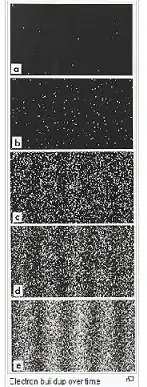The observations at the level of particles, microscopic world of nanometer dimensions, have been fitted and understood with quantum mechanics, and predictions for new observations are very successful with this theory. The microcosm framework is quantum mechanical.
Quantum mechanics depends on a set of postulates for the solutions of quantum mechanical equations. The solutions are complex valued functions, the observables are real numbers. The postulates connect the mathematical solutions to the real measurements by stating that it is the complex conjugate squared of the wave function, a real number, which is relevant to measurements and gives the probability of observing a particle at a specific space time point.
Superposition of wave functions means that there will be interference terms which are due to the mathematical structure of the proposed solution. Superposition is not interaction. It is addition of probabilities following the complex numbers algebra, to get a new wavefunction .
This is clear in laser beam interference experiments, where the beams cross each other without interacting ( two photon interference is very improbable) when not measured but at the a screen interference is seen.
With this background:
Ok, so double slit experiment. The multiple paths the particle simultaneously travels interfere with each other but as it is absorbed, it chooses one "actual" location, thus the energy level remains the same.
A description with multiple paths is a mathematical model to get at the probability distribution. Particles are point particles in the standard model of elementary particle physics. They are not spread out all over the available space for the interaction. It is only the probability of interaction that is varying. When detected particles are consistent with being a point.
The screen shows the solution of the quantum mechanical equations for the experiment "particle scattering off two slits" This is one complex sinusoidal function which squared due to the boundary conditions will give the interference pattern. It is a one particle wave function ( in contrast with the photons of the laser light above) because the interference pattern builds up one particle at a time too.. It builds a probability distribution. The probability that the particle passes through one of the slits and hits the screen has a sinusoidal distribution which shows interference effects.

double slit experiment one electron at a time.
Can the particle only interact in a superposed manner with itself, because if it interacted with something else it would be "observed" and thus have to pick one thing to interact with,
As explained above, superposition is not interaction. In the case of the single particle scattering off the slits, it is the boundary conditions that determine the wavefunction and the properties which will be manifested by accumulating measurements with the same boundary conditions ( momentum, geometry of slits).
or can the particle manage to interact with two things simultaneously?
No, in the existing theory, described with Feynman diagrams, a particle interacts with one particle or field at a time.
